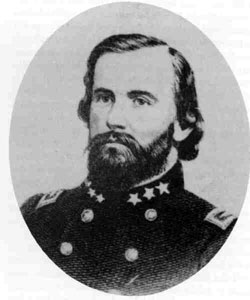
John Hunt Morgan
Confederate cavalry commander John Hunt Morgan was born in Huntsville, Alabama, on June 1, 1825. Educated at Transylvania University, he fought in the Mexican War as a first lieutenant in the Kentucky Mounted Volunteers and saw action at the battle of Buena Vista. Morgan married Rebecca Bruce in 1848. Working as a hemp manufacturer in Lexington, Morgan became a Mason and an active community leader, serving on the school board and city council and as captain of the fire department.
From 1852 to 1854 he served as captain of an artillery company in the state militia. In 1857 he formed the Lexington Rifles and attached the unit to the state guard militia in 1860. Morgan initially supported Kentucky neutrality, but in September 1861, on his own authority, he led the Lexington Rifles in a series of guerrilla raids before officially joining the Confederacy as a captain of cavalry in October 1861.
In April 1862 Morgan was promoted to colonel and continued his raiding activities, earning the sobriquet “Francis Marion of the War.” He led a squadron at the battle of Shiloh. On a raid from Knoxville to Cynthiana, Kentucky, from July 4-28, 1862, he recruited three hundred volunteers for the Confederate cause. On August 12, 1862, Morgan successfully disrupted General Don Carlos Buell’s campaign against Chattanooga by burning the twin Louisville and Nashville Railroad tunnels near Gallatin, which were vital links in the Union supply line. Embarrassed by this loss, Buell sent his entire cavalry force against Morgan and suffered a rout, including the capture of General Richard Johnson. Morgan’s success emboldened Confederate plans for a Kentucky invasion, and Morgan’s cavalry joined General Braxton Bragg in the Perryville campaign. On December 7, 1862, Morgan captured a garrison of 1,834 Union troops at Hartsville, Tennessee.
In Murfreesboro, on December 14, 1862, Morgan, widowed since 1861, married seventeen-year-old Martha “Mattie” Ready in what was the highlight of the city’s winter social season. Most of the Confederate high command attended the ceremony, which was performed by Lieutenant General (and Bishop) Leonidas Polk. This marriage produced a daughter, Johnnie, who was born after Morgan’s death. Two weeks after the wedding, Morgan’s troops participated in raids during the battle of Stones River, diverting Union troops from assisting General William S. Rosecrans’s army.
During his raids, Morgan often avoided direct combat through tactical plans which involved ruse and deception, including intercepting telegraph messages and sending out false ones to Union commands. During 1862 his command grew from 325 to a division of 3,900 and he was promoted to brigadier general on December 11, 1862.
In early 1863, as Union cavalry in the western theater gained proficiency and strength, Morgan began suffering losses in his confrontations. In an attempt to recoup some lost prestige and morale, he embarked on his legendary “Great Raid.” Morgan led his troops on an unauthorized raid through Kentucky, Indiana, and Ohio. During the raid, which lasted from July 1 to 26, 1863, Morgan spread panic in each successive town he approached, encountering hastily convened militia who offered relatively weak resistance. Passing through southern Indiana, he crossed into Ohio at Harrison, and moved within seven miles of Cincinnati. Captured with most of his command at West Point, Ohio, Morgan escaped from the Ohio State Penitentiary on November 27, 1863, and returned to Kentucky. His “Great Raid” was the northernmost incursion of western Confederate troops and served to bolster Southern morale after Lee’s defeat at Gettysburg. It also served to secure Morgan’s legendary status among Civil War generals.
Despite the Confederate high command’s anger at his unauthorized, impetuous raid, he was restored to command. Reports of looting by Morgan’s men during an unsuccessful raid near Cynthiana, Kentucky, in June 1864 led to his suspension from command and the scheduling of a court of inquiry for September 10. Morgan was surprised by Federal soldiers in Greeneville, Tennessee, on September 4, and died attempting to escape. Originally buried in Richmond, Virginia, his body was moved to Lexington, Kentucky, in 1868.
Suggested Reading
James A. Ramage, Rebel Raider: The Life of General John Hunt Morgan (1986)



